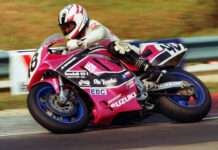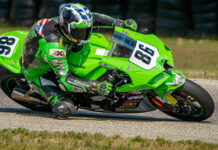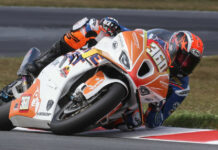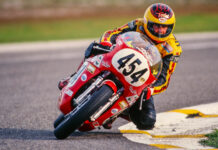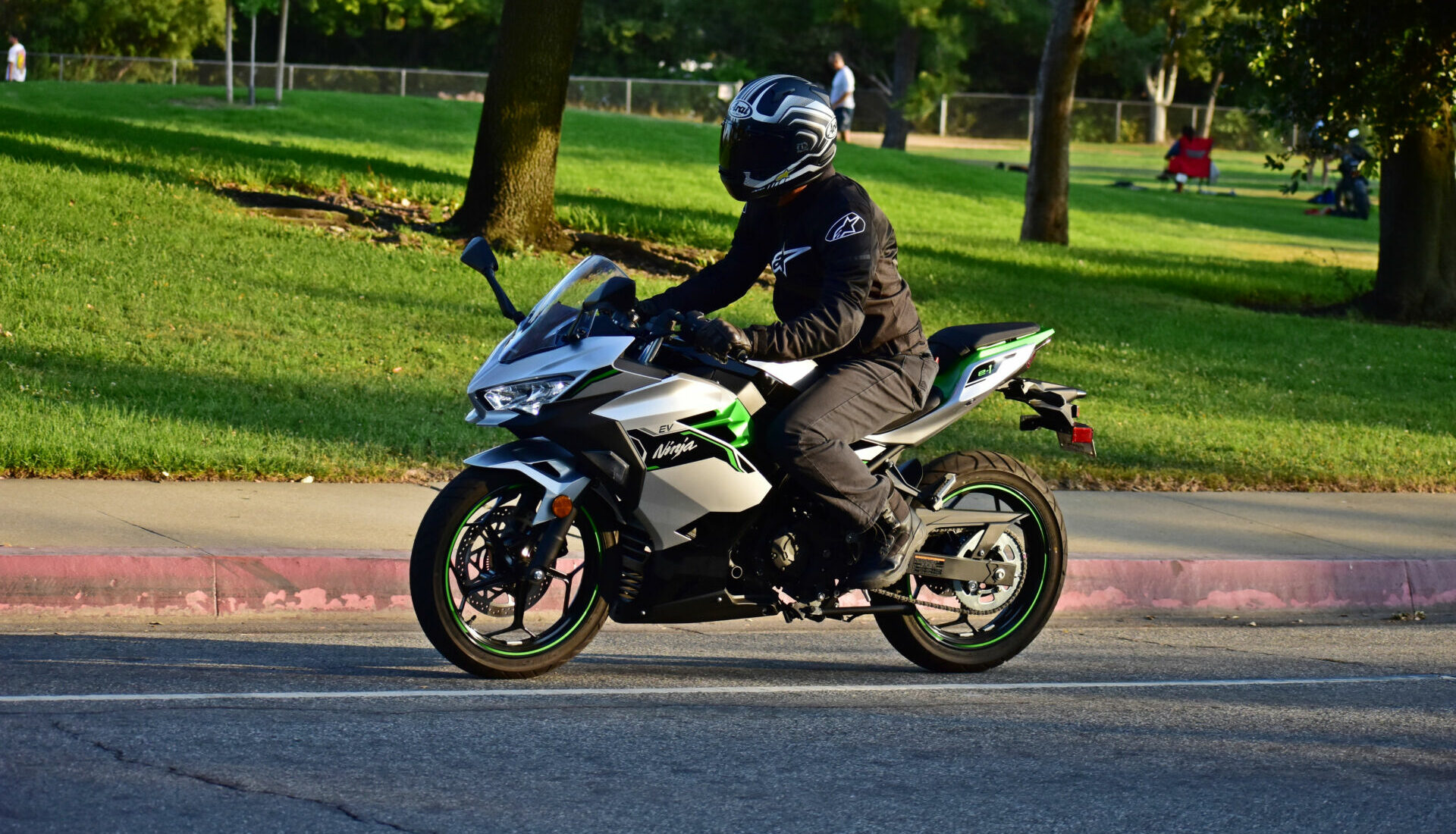Charging Into Phase Two Of Electric Motorcycling
By Michael Gougis
“Cool ******* bikes!” the rider on the Suzuki GSX-R shouted at us. He had to shout over his machine, but ours were dead silent. We were test riding the all-electric Maeving RM1S down Sunset Boulevard and through the heart of Beverly Hills, where private security guards drove around in Teslas and driver-less electric taxis glided eerily through streets packed with tourists and students.
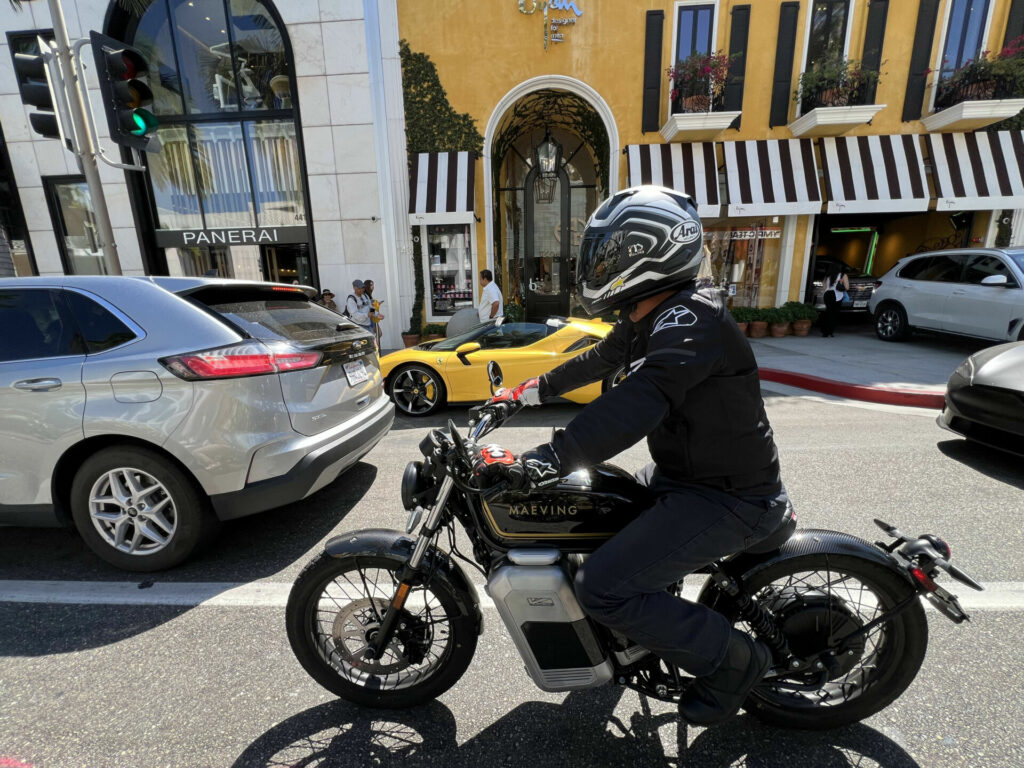
“Cool,” I found myself thinking a week later, whispering home on the Kawasaki Ninja e-1 late at night on the dark, empty streets of eastern Los Angeles County, the scenery whipping past to the soundtrack of wind noise past my helmet and nothing else.
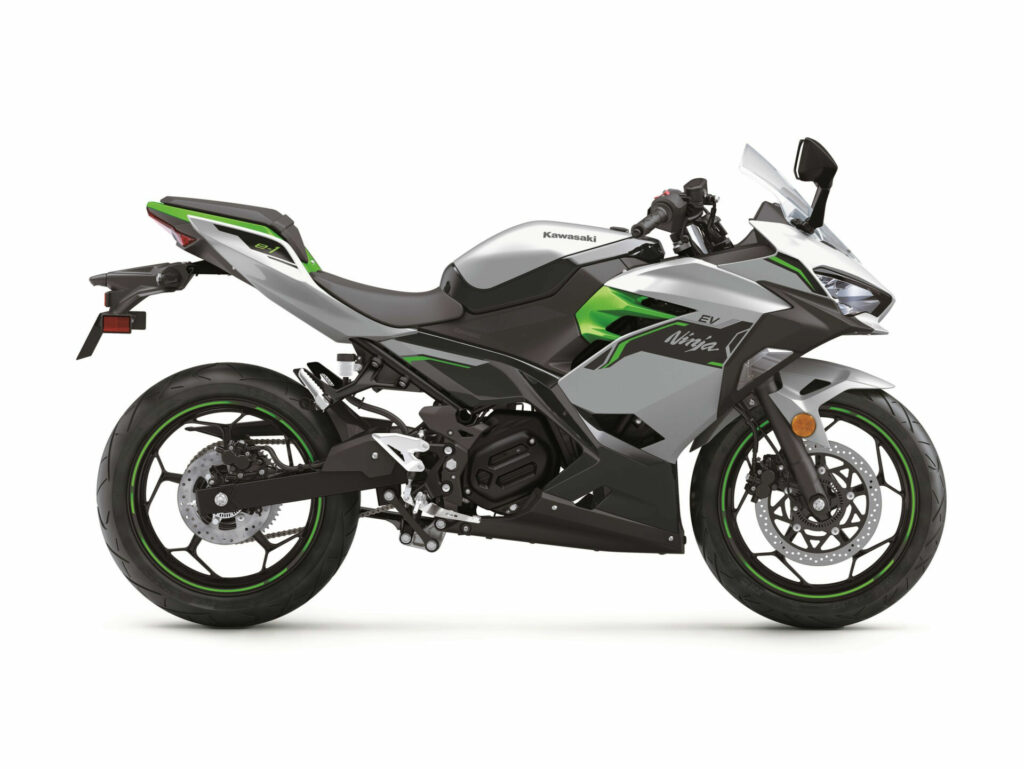
The bikes couldn’t look less different. The Ninja looks like a Ninja, perhaps drawn to a slightly smaller scale than its gas-powered siblings, but absolutely reflecting the current design state of a Kawasaki supersport machine. The Maeving looks like it was ripped out of a history book, and based solely on the styling, I wouldn’t have been surprised to find a hand-shifter onboard.
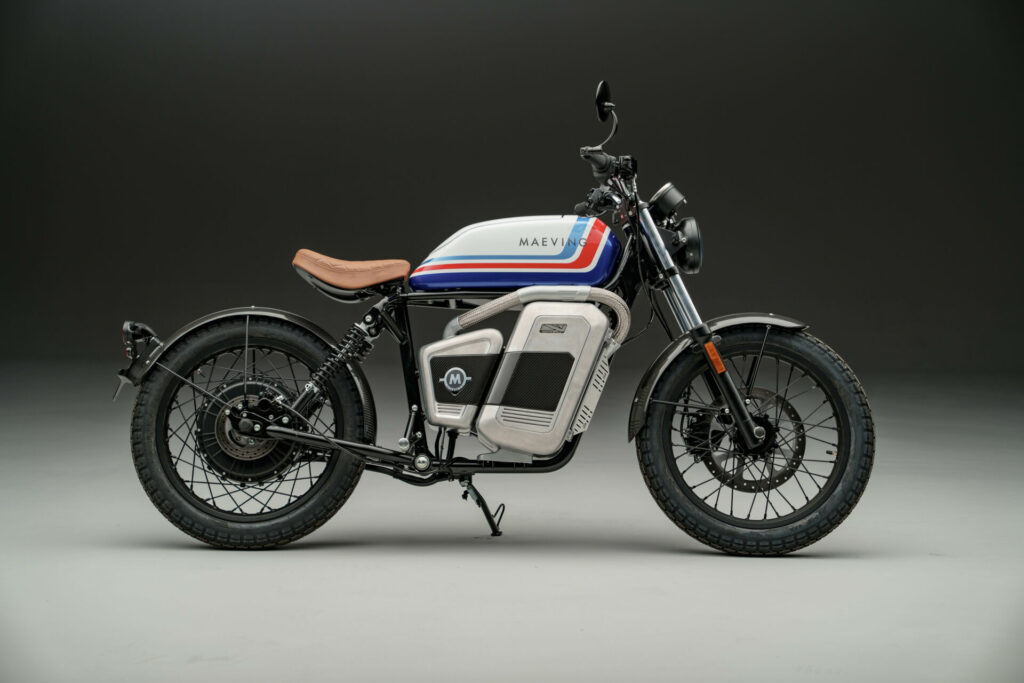
But these machines both represent a new way of thinking about electric motorcycles. Instead of trying to replicate the performance of internal-combustion machines, these are designed to deliver city-oriented performance, affordability, and ease of use. And they are designed to more accurately meet the needs of the people most likely to be looking for such a motorcycle.
Electric motorcycles can make a lot of sense in dense urban environments. There’s no noise pollution, no exhaust emissions. They are cheap to maintain and torquey leaving a stoplight. There’s a reason more than eight million electric motorcycles and scooters are sold in China every year, and that the popularity of such machines is soaring in crowded population centers worldwide.
The problem has always been charging. A relatively short range isn’t a problem if the bike can be recharged quickly. But the buyer for a city motorcycle is likely to live in an apartment or condo, and they may not have access to an outlet in a garage to charge the vehicle. Near my home in Vancouver, I have seen people drop extension cords from their third-story apartments to charge an electric motorcycle sitting in a ground-level parking lot. Not ideal.
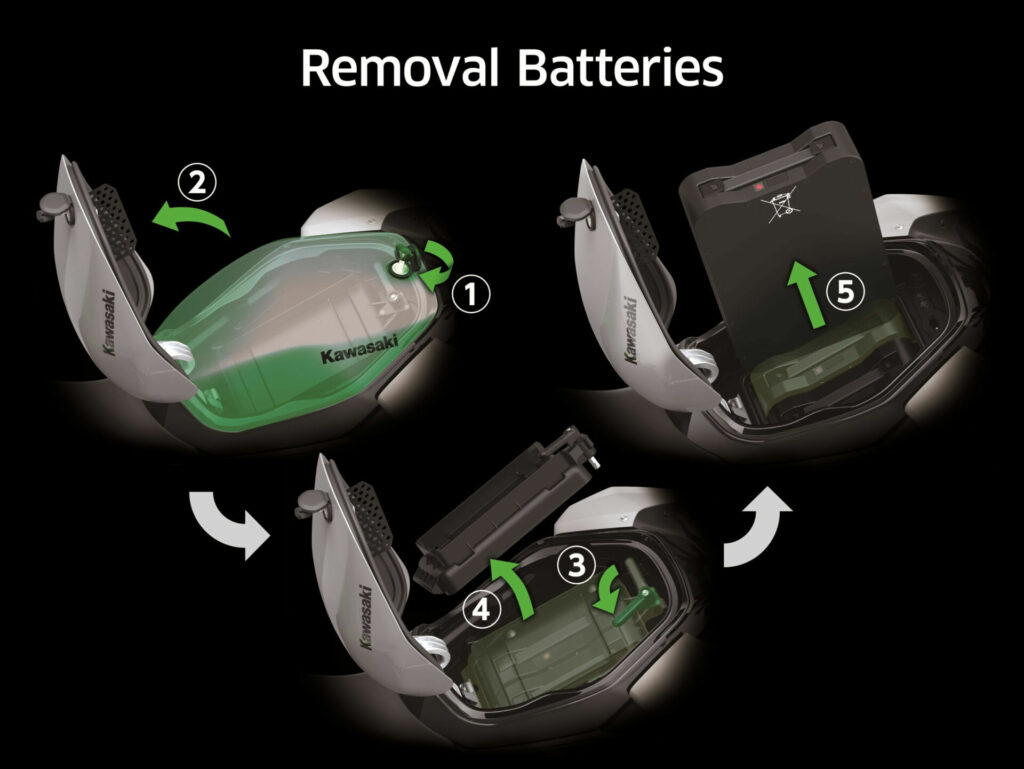
Honda offered one solution with its Motocompacto, the electric scooter that folds into itself and slides under the couch while charging. California-based Ryvid offered a battery pack that drops down onto a set of wheels and rolls around like luggage to the nearest standard outlet.
The Kawasaki and Maeving take this idea one step further. Both can be charged with the batteries on board. But, and this is the evolutionary step, both offer removable batteries that can be charged in an apartment, a condo, or anywhere there’s an outlet. Each individual battery weighs about as much as a big bag of dog food. If you’re like me, and enjoy spending time in coffee shops (a writer in a coffee shop is a cliche, I know), there’s no reason you couldn’t carry a battery in with you and charge it while you get charged on a double espresso.
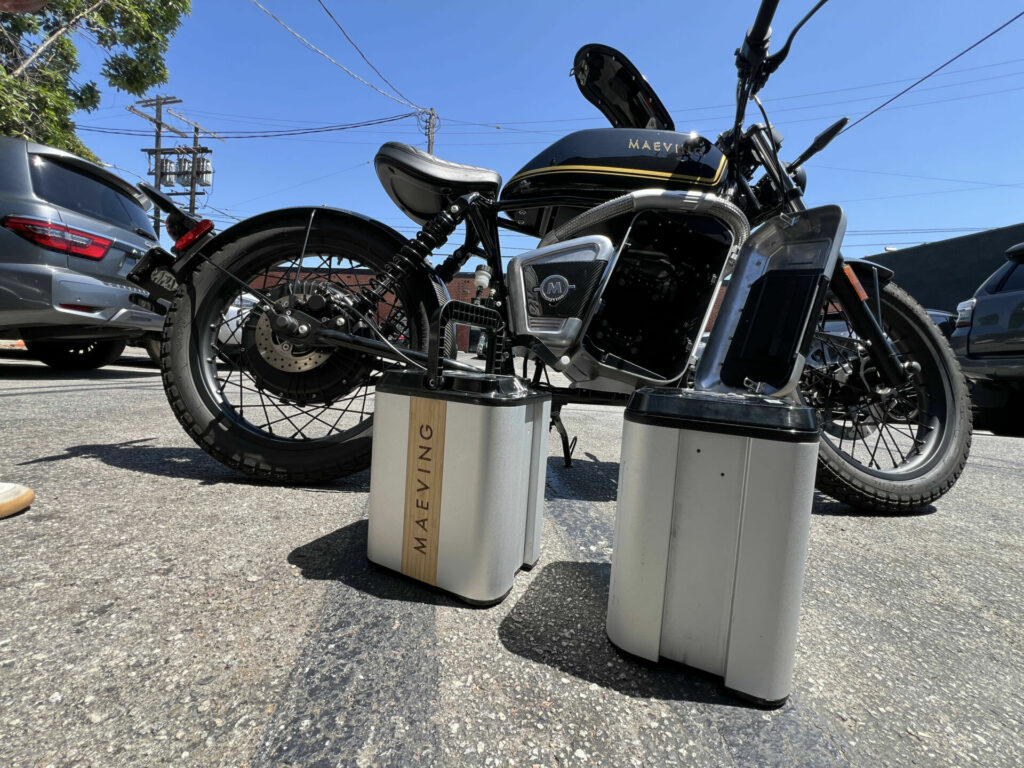
And it’s an answer–a pretty good one–for the people who wanted an electric bike for the city but didn’t have anywhere to charge it.
Maeving RM1S
The Maeving RM1S, as I like to say, looks like what a non-motorcyclist thinks of when they hear the word “motorcycle.” The company says its design is inspired by the board track racers of the 1920s and the café racer era. The styling is critical to Maeving, which went to great lengths to evoke the impression of a classic or vintage machine. The tube that carries cables from the battery compartment rearward evokes the image of a high-mounted exhaust pipe. There are cool bar-end mirrors, an analog speedometer, and a diamond-stitched seat.
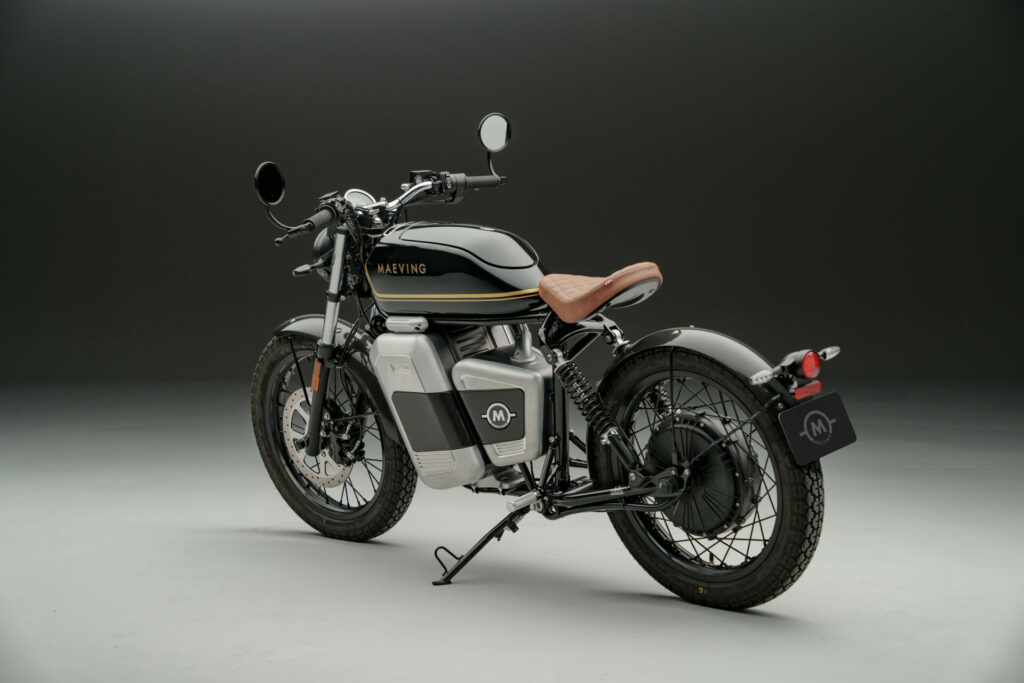
The single-downtube steel-cradle frame surrounds the dual battery pack, while a rear hub-mounted motor delivers a claimed 14 bhp. The company claims a curb weight of 293 pounds, and the seat height is 30.9 inches.
Conventional damper-rod forks handle suspension duties up front, and twin shocks– adjustable for preload only–mounted directly to the steel swingarm soak up bumps at the rear. The linked braking system features a single 300mm disc mated to a three-piston caliper and a wire-spoked wheel in the front, and a single 180mm disc is clamped by a single-piston caliper at the rear.
There is no clutch or transmission. There are three ride modes–Ride, Sport and Eco. The company claims a top speed of 70 mph and a range of 80 miles, and a zero-to-full charge time of just over four hours from a 120-volt home wall socket. Charging is via a port on the side of the bike or by removing the batteries and charging them someplace else.
Options include carbon-fiber fenders, seat and tank colors, and upgraded suspension. The company sells directly to the customer. Buy one and a company representative will deliver it and shows the buyer how it operates. If it needs repair, a company technician comes to get the bike, takes it back to the shop, fixes it, and brings it back.
Suggested retail for the RM1S (the upscale, twin-battery model) begins at $8,995. The base single-battery RM1 is sold out.
Kawasaki Ninja e-1
Kawasaki took the opposite approach when it styled the Ninja e-1. Taking full advantage of the fact that sportbikes have full fairings, Kawasaki wrapped bodywork around the electric Ninja’s battery pack. It takes a careful look to spot the electric motor, mounted behind the battery compartment, and the only other real clue that it’s an electric bike is the lack of an exhaust pipe. The fit and finish is right up there with Kawasaki’s other sporting motorcycles, and it slots right in with the other sportbikes in a parking lot.
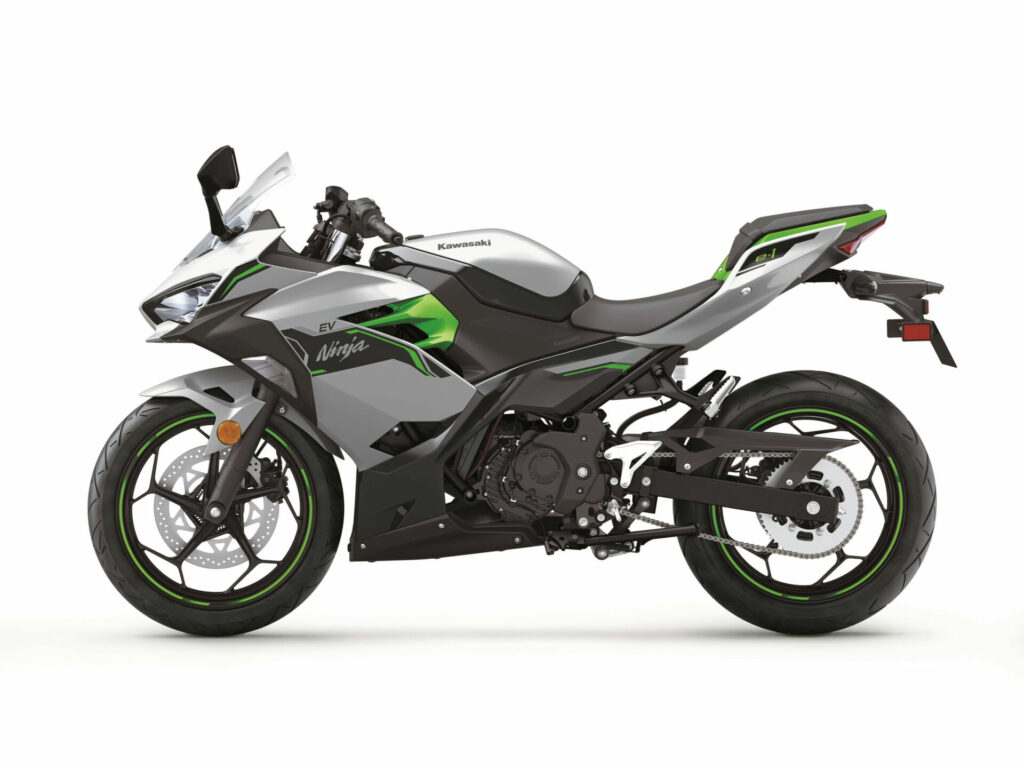
The steel-tube frame cradles the dual battery compartment, and like the Maeving, the area traditionally occupied by the gas tank is a lockable storage container. Conventional damper-rod forks mount to a lightweight alloy rim and a single 290mm disc with a dual-piston caliper. A gas-charged monoshock, adjustable for preload only, handles suspension at the rear, where a dual-piston caliper works with a 220mm disc.
Kawasaki engineers avoided the extra unsprung weight of a hub-mounted motor, so the Ninja e-1 has its motor mounted just ahead of the swingarm. A traditional sprocket-and-chain system transmits power to the rear wheel. Kawasaki claims 12.06 horsepower from its air-cooled, interior permanent magnet motor, a range of 41 miles, and a top speed of 55 mph. The claimed maximum torque, 29.7 lbs.-ft, is just two lbs.-ft. shy of the claimed max torque of the new Ninja 500, and the e-1 delivers its peak torque starting at 500 rpm.
On the Roadracing World scales, the e-1 weighed in at 313 pounds, and Kawasaki also claims a seat height of 30.9 inches. Kawasaki says the charging time is approximately 3.7 hours.
The e-1 has two ride modes, Eco and Road, plus ABS braking. There’s also a little button on the right handlebar called e-boost, which delivers a short burst of power for leaving stoplights or merging with traffic. The machine also offers a Walk mode that limits the speed to 3.0 mph, but the cool thing is that it works in reverse as well as forward, making parking easier. Suggested retail starts at $7,899.
Riding The Electric Bikes
The Maeving looks every bit the part that the designers intended. Maeving’s engineers–formerly of Triumph, the company says–opted for a classic, timeless look, and onlookers responded positively. Drivers stopped their vehicles and started shouting questions and praise. Impressive when you’re cruising through a global nexus of fashion like Rodeo Drive, where it seems like every other car is a Ferrari or Porsche.
Leaving a stoplight in Sport mode, the Maeving was just quick enough to leave traffic behind initially, but the rate of acceleration faded quickly. It’s powerful enough to manage city traffic, but acceleration is by design soft and unintimidating. Maeving’s target audience includes riders moving up from e-bicycles, and the power delivery is meant to be manageable for them. Highways are a bit intimidating with the lack of top end, but if jumping on the freeway for a couple of exits makes the trip shorter, and there’s enough room to build up speed, the Maeving is game. The trade-off for the softer, manageable power is the greater range. Even with the convenience of removable batteries, more range means less time spent charging and greater usability.
The seat feels low, the bike is easy to maneuver, and the brakes are adequate for the task. The bike feels vintage when the pace picks up, and that’s not necessarily a good thing. All that weight at the end of the swingarm makes its presence known going over bumps, with the rear shocks unable to completely handle the most aggressive pavement irregularities. The chassis feels flexible through faster turns, and having identical tires front and rear also adds an element of unfamiliarity to the experience. It has to be said, though, that this is at the very limit–or beyond–of the bike’s design brief, and most riders will be too busy basking in the admiration of passersby to notice. When ridden as intended, the seat is comfortable, the riding position relaxed, and the quiet, vibration-free experience quite enjoyable.
The Ninja delivers a much more typical riding experience. Bumps don’t upset it nearly as much, since the electric motor isn’t unsprung weight. And while the suspension is small-bore Ninja standard, it’s more than adequate for anything city streets will throw at it. The single-disc front brake delivers a solid lever feel, and ABS is there in case the rider gets the braking wrong.
Kawasaki says the Ninja e-1 tops out at 55 mph, but I got it up to an indicated 60 mph. The Eco mode is definitely cruise-around-the-neighborhood mode, while Road mode works best for faster boulevards. Using the e-boost button turned out to be a giggle. Punch the button before leaving a light and pin the throttle, and the Ninja moves with much more authority than the Maeving. It’s not going to rip your arms off, but it delivers almost as much torque as the new Ninja 500, more torque than a Ninja 400, and serves it up starting at 500 rpm. I used the e-boost button to leave stoplights while lane splitting, turned it off once up to cruising speed, and thoroughly enjoyed using the little Ninja as my around-town scoot for a couple of weeks.
I’ve ridden bigger, more powerful electric bikes and enjoyed them–the acceleration is amazing. The Maeving and Ninja e-1 are made for a different audience, and within their performance envelope, they do everything that they promise. I’m lucky enough to have a garage and solar panels at my Southern California home, and it did not escape my attention that not only did I never have to stop at a gas station, I stopped paying attention to gas prices. For a rider looking for electric city transportation that is cheap and convenient, with charging flexibility, these are worth a look.
Specifications: 2024 Kawasaki Ninja e-1
Engine Configuration: Interior Permanent Magnet, Electric Motor
Engine Cooling: Air
Claimed Peak Horsepower: 12.06 bhp
Claimed Peak Torque: 29.7 lbs.-ft.
Battery (Capacity): Dual Lithium-Ion (60.0 Ampere-Hour Each, 50.4 Volts)
Rider Aides: ABS
Frame Design (Material): Trellis (Steel)
Rake/Trail: 24.4 degrees/3.7 inches (94mm)
Claimed Wheelbase: 53.9 inches (1,369mm)
Measured Swingarm Length: 21.0 inches (533mm)
Seat Height: 30.9 inches (785mm)
Footpeg Height: 12.5 inches (318mm)
Handlebar Height: 36.8 inches (934mm)
Steering Stem to Seat Center: 22.0 inches (559mm)
Front Forks: Telescopic
Fork Tube Diameter: 41mm
Fork Adjustments: N.A.
Front Wheel Travel: 4.7 inches (120mm)
Rear Wheel Travel: 5.2 inches (132mm)
Rear Suspension Type: Single Shock, Bottom-link Uni-Trak Linkage
Rear Shock Adjustments:
Rebound Damping: N.A.
Compression Damping: N.A.
Spring Preload: Ramp-Type Adjuster, 4.0-inch Range
Front Brake: Single 290mm (11.4-inch) Disc w/2-piston Nissin Caliper
Rear Brake: Single 220mm (8.6-inch) Disc w/2-piston Nissin Caliper
Front Wheel: 2.75 x 17-inch, Aluminum
Rear Wheel: 3.50 x 17-inch, Aluminum
Front Tire: 100/80-17 IRC Road Winner Bias-Ply
Rear Tire: 130/70-17 IRC Road Winner Bias-Ply
Measured Curb Weight: 313 lbs. (142 kg)
Weight Distribution, Percent (F/R): 57.0/43.0
GVWR: 706 lbs. (320 kg)
Overall Length: 78.0 inches (1,981mm)
Overall Width: 27.0 inches (686 mm)
Overall Height: 43.5 inches (1,105 mm)
Ground Clearance: 7.5 inches (191mm)
Suggested Retail Price: $7,899
Specifications: 2024 Maeving RM1S
Engine Configuration: Hub-Mounted, Direct-Drive, Electric Motor
Engine Cooling: Air
Claimed Peak Horsepower: 14.0 bhp
Claimed Peak Torque (at ground): 184.0 lbs.-ft.
Battery (Capacity): Dual Lithium-Ion (26.4 Ampere-Hour Each, 51.7 Volts)
Rider Aids: Linked Brakes
Frame Design (Material): Single Downtube Cradle (Steel)
Rake/Trail: 26.0 degrees/4.0 inches (102mm)
Claimed Wheelbase: 54.9 inches (1,396mm)
Measured Swingarm Length: 18.5 inches (470mm)
Seat Height: 30.9 inches (785mm)
Footpeg Height: 11.5 inches (292mm)
Handlebar Height: 39.0 inches (990mm)
Steering Stem to Seat Center: 25.5 inches (648mm)
Front Forks: Telescopic
Fork Tube Diameter: 37mm
Fork Adjustments: N.A.
Front Wheel Travel: 4.3 inches (110mm)
Rear Wheel Travel: 3.9 inches (100mm)
Rear Suspension Type: Dual K-Tech Shocks
Rear Shock Adjustments:
Rebound Damping: 40-Click Range
Compression Damping: N.A.
Spring Preload: Threaded Collar, 2.0-inch Range
Front Brake: Single 300mm (11.8-inch) Disc w/3-piston LBN Caliper
Rear Brake: Single 180mm (7.1-inch) Disc w/single-piston LBN Caliper
Front Wheel: 2.15 x 19-inch, Aluminum
Rear Wheel: 2.15 x19-inch, Aluminum
Front Tire: 3.25 x 19 Dunlop K70 Bias-Ply
Rear Tire: 3.25 x 19 Dunlop K70 Bias-Ply
Claimed Curb Weight: 326 lbs. (148 kg)
Weight Distribution, Percent (F/R): N.A.
GVWR: 595 lbs. (290 kg)
Overall Length: 84.4 inches (2,145mm)
Overall Width: 35.3 inches (896mm)
Overall Height: 42.0 inches (1,067mm)
Ground Clearance: 9.0 inches (228mm)
Suggested Retail Price: $8,995


